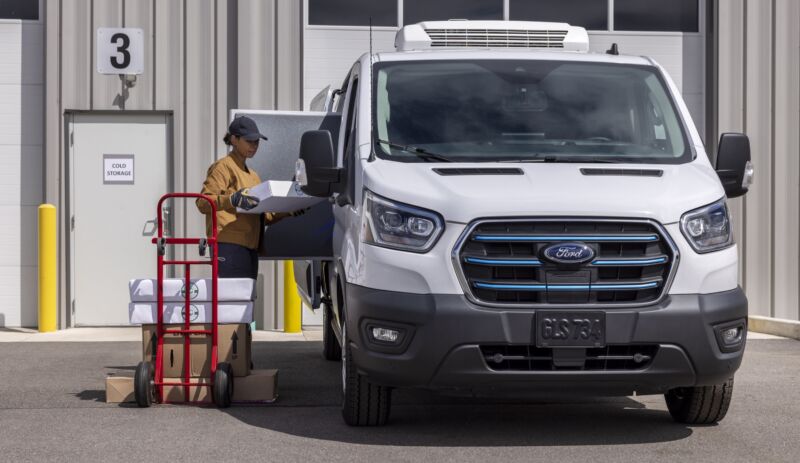
Ford
America’s tradespeople have steadily been getting more van-curious over the years, helped no doubt by Ford beginning local production of the already Euro-popular Transit in Kansas City in 2014. In 2022 Ford debuted the E-Transit, which has been steadily growing in sales over the past few quarters. Now the Blue Oval has started deliveries of the model-year 2024 E-Transit, and there are some worthwhile improvements compared to the MY23 van.
The opprobrium that is now starting to stick to supersized pickup trucks has mostly ignored the humble van. It’s contradictory, on the face of it; even a low-roof Transit takes up more volume on the road than most pickups. But then, there aren’t leather-and-chrome special edition Transit vans driven more as commuter cars or weekend toys like there are pickups—at least for now.
EV vans ought to be even more immune, for they maintain their working class credentials and burnish them with a side helping of environmentalism. For example, Ford says that data from its telematics show that since its introduction in 2022 until the end of Q2 2024, E-Transit customers in the US and Canada had avoided burning more than 3 million gallons of gas (11.3 million L) and reduced their output of CO2 by 25 million kg.
Bigger battery, more range
For MY24, the E-Transit’s lithium-ion battery pack grew to 89 kWh, up from 68 kWh. How much range that translates to depends on the configuration of the van. The low roof E-Transit can go the farthest on a single charge thanks to the smallest frontal area—in this case 159 miles (256 km) up from 126 miles (203 km). The medium roof E-Transit has a range of 148 miles (238 km), and the high roof E-Transit can drive 143 miles (230 km) on a single charge.
Ford has beefed up the E-Transit’s charging, too. It can now DC fast charge at up to 176 kW, with 28 minute 10–80 percent fast charging times. The onboard AC charger is now 19.2 kW, and on an 80 A level 2 charger—which Ford will happily sell you—a 0–100 percent charge takes 6 hours 11 minutes. (At 32 A, a full charge takes 14 hours 20 min.)
Another neat improvement concerns the 2.4 kW onboard AC power outlets, which will now supply power while the van is in motion, opening up a range of new applications for E-Transits.
-
Power and torque is unchanged, and the E-Transit has a full suite of driver assists including one that scolds you every time you accelerate with what it considers too much vigor.
Ford -
Putting the charge port in the nose was rather smart.
Ford -
Ford’s Kansas City plant has built more than 1.2 million Transits since 2014. Local production means the E-Transit qualifies for a $7,500 commercial clean vehicle tax credit.
Ford
You might be expecting a big price hike, given the 30 percent increase in battery capacity from MY23. But Ford Pro has kept the price of the Chassis Cab ($46,495) and Cutaway ($45,995) E-Transits the same as the smaller-battery vans. The cargo van has gone up $1,500 to $51,490, however.




















+ There are no comments
Add yours